2014 KIA Sedona engine coolant
[x] Cancel search: engine coolantPage 326 of 382
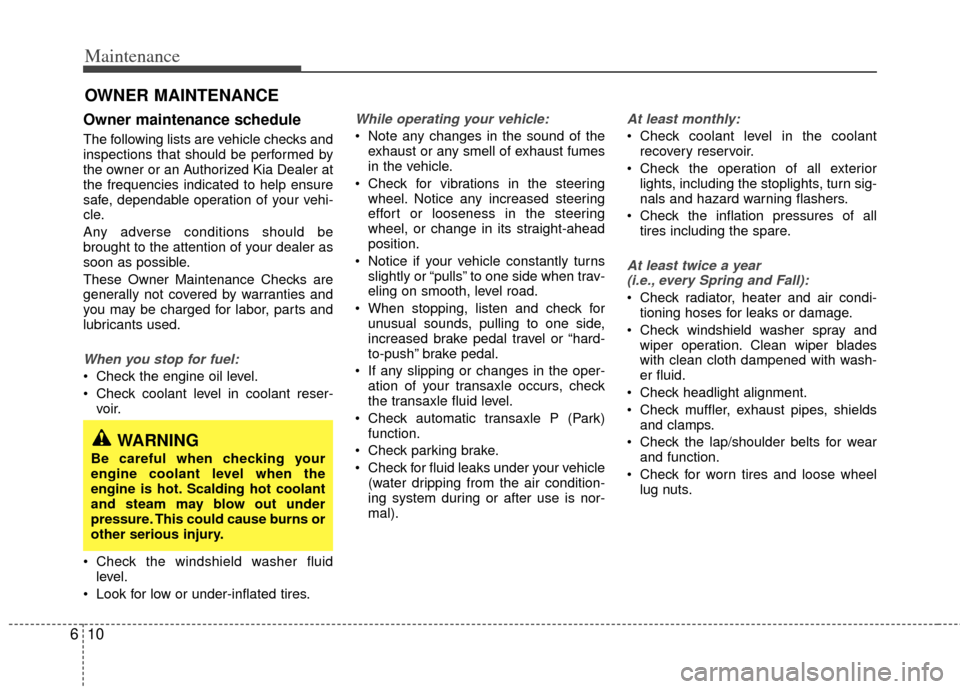
Maintenance
10
6
OWNER MAINTENANCE
Owner maintenance schedule
The following lists are vehicle checks and
inspections that should be performed by
the owner or an Authorized Kia Dealer at
the frequencies indicated to help ensure
safe, dependable operation of your vehi-
cle.
Any adverse conditions should be
brought to the attention of your dealer as
soon as possible.
These Owner Maintenance Checks are
generally not covered by warranties and
you may be charged for labor, parts and
lubricants used.
When you stop for fuel:
Check the engine oil level.
Check coolant level in coolant reser-
voir.
Check the windshield washer fluid level.
Look for low or under-inflated tires.
While operating your vehicle:
Note any changes in the sound of the exhaust or any smell of exhaust fumes
in the vehicle.
Check for vibrations in the steering wheel. Notice any increased steering
effort or looseness in the steering
wheel, or change in its straight-ahead
position.
Notice if your vehicle constantly turns slightly or “pulls” to one side when trav-
eling on smooth, level road.
When stopping, listen and check for unusual sounds, pulling to one side,
increased brake pedal travel or “hard-
to-push” brake pedal.
If any slipping or changes in the oper- ation of your transaxle occurs, check
the transaxle fluid level.
Check automatic transaxle P (Park) function.
Check parking brake.
Check for fluid leaks under your vehicle (water dripping from the air condition-
ing system during or after use is nor-
mal).
At least monthly:
Check coolant level in the coolantrecovery reservoir.
Check the operation of all exterior lights, including the stoplights, turn sig-
nals and hazard warning flashers.
Check the inflation pressures of all tires including the spare.
At least twice a year (i.e., every Spring and Fall):
Check radiator, heater and air condi- tioning hoses for leaks or damage.
Check windshield washer spray and wiper operation. Clean wiper blades
with clean cloth dampened with wash-
er fluid.
Check headlight alignment.
Check muffler, exhaust pipes, shields and clamps.
Check the lap/shoulder belts for wear and function.
Check for worn tires and loose wheel lug nuts.
WARNING
Be careful when checking your
engine coolant level when the
engine is hot. Scalding hot coolant
and steam may blow out under
pressure. This could cause burns or
other serious injury.
Page 328 of 382

Maintenance
12
6
ENGINE COMPARTMENT
1. Engine coolant reservoir
2. Engine oil filler cap
3. Brake fluid reservoir
4. Air cleaner
5. Fuse box
6. Negative battery terminal
7. Positive battery terminal
8. Radiator cap
9. Engine oil dipstick
10. Power steering fluid reservoir
11. Windshield washer fluid reservoir
OVQ063001N* The actual engine room in the vehicle may differ from the illustration.
Page 330 of 382
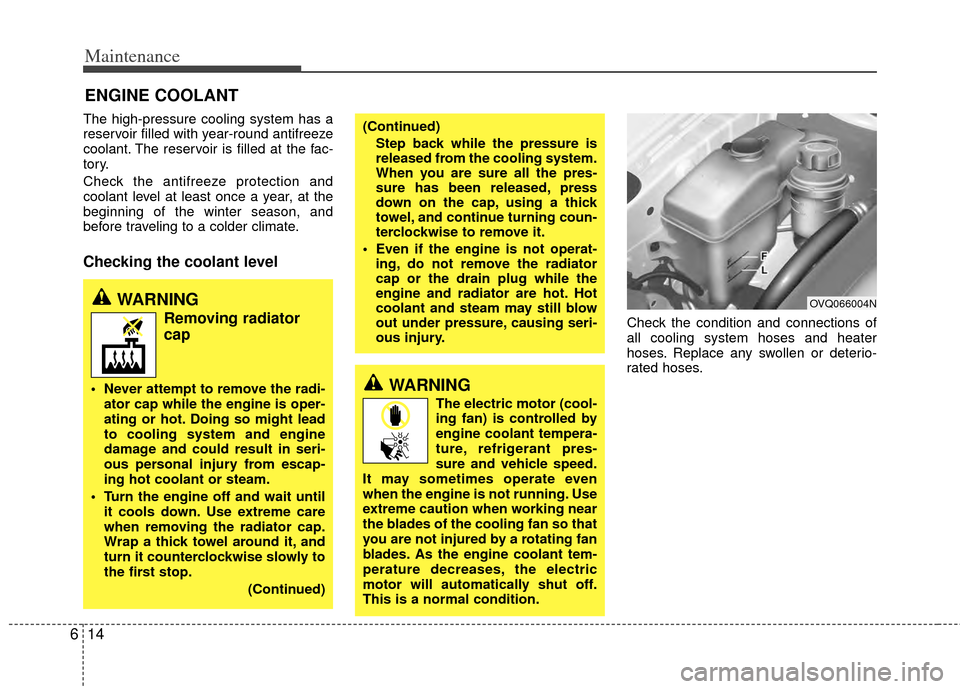
Maintenance
14
6
ENGINE COOLANT
The high-pressure cooling system has a
reservoir filled with year-round antifreeze
coolant. The reservoir is filled at the fac-
tory.
Check the antifreeze protection and
coolant level at least once a year, at the
beginning of the winter season, and
before traveling to a colder climate.
Checking the coolant level
Check the condition and connections of
all cooling system hoses and heater
hoses. Replace any swollen or deterio-
rated hoses.
WARNING
Removing radiator
cap
Never attempt to remove the radi-
ator cap while the engine is oper-
ating or hot. Doing so might lead
to cooling system and engine
damage and could result in seri-
ous personal injury from escap-
ing hot coolant or steam.
Turn the engine off and wait until it cools down. Use extreme care
when removing the radiator cap.
Wrap a thick towel around it, and
turn it counterclockwise slowly to
the first stop.
(Continued)
(Continued)Step back while the pressure is
released from the cooling system.
When you are sure all the pres-
sure has been released, press
down on the cap, using a thick
towel, and continue turning coun-
terclockwise to remove it.
Even if the engine is not operat- ing, do not remove the radiator
cap or the drain plug while the
engine and radiator are hot. Hot
coolant and steam may still blow
out under pressure, causing seri-
ous injury.
OVQ066004N
WARNING
The electric motor (cool-
ing fan) is controlled by
engine coolant tempera-
ture, refrigerant pres-
sure and vehicle speed.
It may sometimes operate even
when the engine is not running. Use
extreme caution when working near
the blades of the cooling fan so that
you are not injured by a rotating fan
blades. As the engine coolant tem-
perature decreases, the electric
motor will automatically shut off.
This is a normal condition.
Page 331 of 382
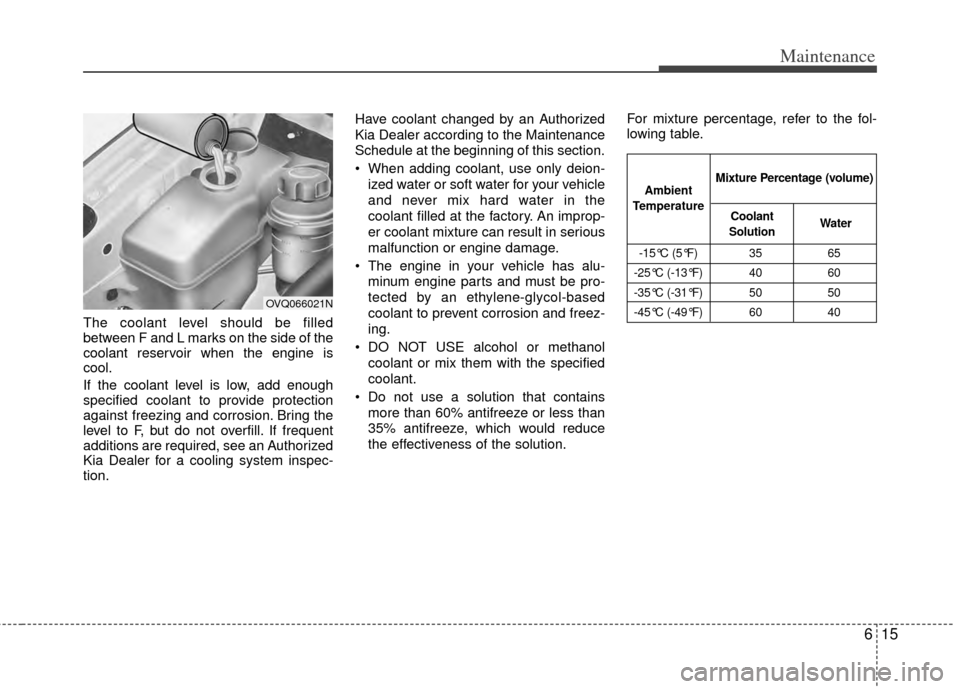
615
Maintenance
The coolant level should be filled
between F and L marks on the side of the
coolant reservoir when the engine is
cool.
If the coolant level is low, add enough
specified coolant to provide protection
against freezing and corrosion. Bring the
level to F, but do not overfill. If frequent
additions are required, see an Authorized
Kia Dealer for a cooling system inspec-
tion.Have coolant changed by an Authorized
Kia Dealer according to the Maintenance
Schedule at the beginning of this section.
When adding coolant, use only deion-
ized water or soft water for your vehicle
and never mix hard water in the
coolant filled at the factory. An improp-
er coolant mixture can result in serious
malfunction or engine damage.
The engine in your vehicle has alu- minum engine parts and must be pro-
tected by an ethylene-glycol-based
coolant to prevent corrosion and freez-
ing.
DO NOT USE alcohol or methanol coolant or mix them with the specified
coolant.
Do not use a solution that contains more than 60% antifreeze or less than
35% antifreeze, which would reduce
the effectiveness of the solution. For mixture percentage, refer to the fol-
lowing table.
-15°C (5°F) 35
65
-25°C (-13°F) 40 60
-35°C (-31°F) 50 50
-45°C (-49°F) 60 40
Ambient
Temperature Mixture Percentage (volume)
Coolant
Solution Water
OVQ066021N
Page 332 of 382
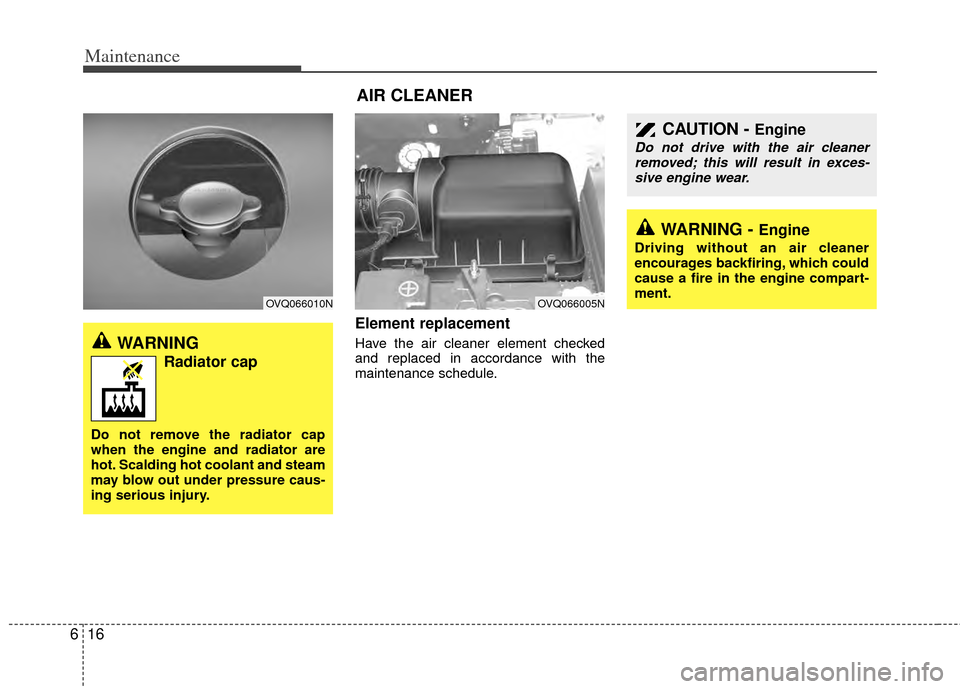
Maintenance
16
6
Element replacement
Have the air cleaner element checked
and replaced in accordance with the
maintenance schedule.
OVQ066005N
WARNING
Radiator cap
Do not remove the radiator cap
when the engine and radiator are
hot. Scalding hot coolant and steam
may blow out under pressure caus-
ing serious injury.
OVQ066010N
WARNING - Engine
Driving without an air cleaner
encourages backfiring, which could
cause a fire in the engine compart-
ment.
CAUTION - Engine
Do not drive with the air cleaner
removed; this will result in exces- sive engine wear.
AIR CLEANER
Page 334 of 382
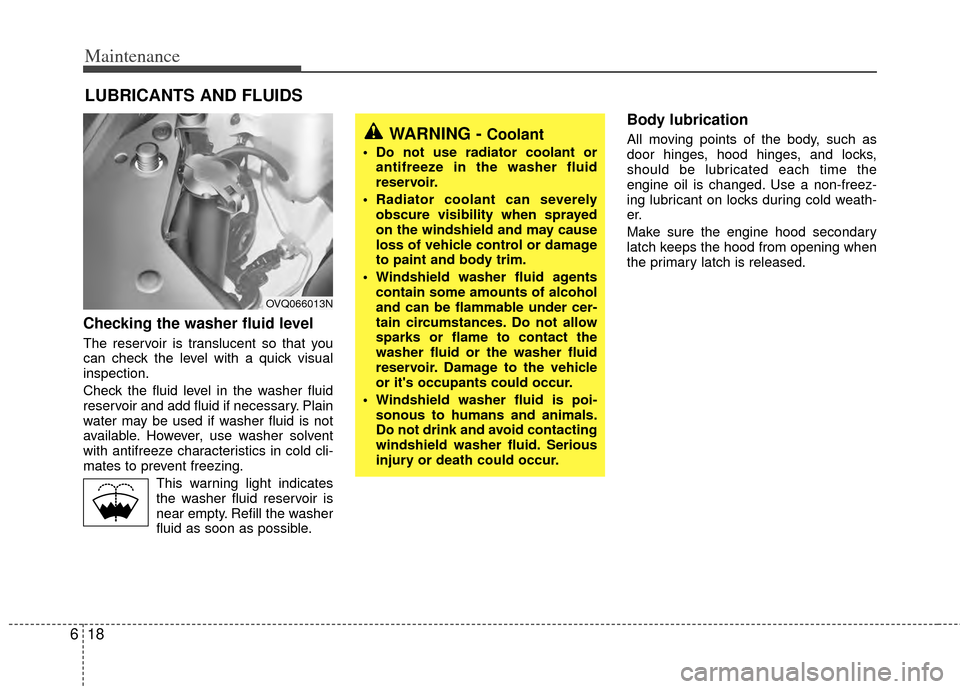
Maintenance
18
6
LUBRICANTS AND FLUIDS
Checking the washer fluid level
The reservoir is translucent so that you
can check the level with a quick visual
inspection.
Check the fluid level in the washer fluid
reservoir and add fluid if necessary. Plain
water may be used if washer fluid is not
available. However, use washer solvent
with antifreeze characteristics in cold cli-
mates to prevent freezing.
This warning light indicatesthe washer fluid reservoir is
near empty. Refill the washer
fluid as soon as possible.
Body lubrication
All moving points of the body, such as
door hinges, hood hinges, and locks,
should be lubricated each time the
engine oil is changed. Use a non-freez-
ing lubricant on locks during cold weath-
er.
Make sure the engine hood secondary
latch keeps the hood from opening when
the primary latch is released.WARNING - Coolant
Do not use radiator coolant or antifreeze in the washer fluid
reservoir.
Radiator coolant can severely obscure visibility when sprayed
on the windshield and may cause
loss of vehicle control or damage
to paint and body trim.
Windshield washer fluid agents contain some amounts of alcohol
and can be flammable under cer-
tain circumstances. Do not allow
sparks or flame to contact the
washer fluid or the washer fluid
reservoir. Damage to the vehicle
or it's occupants could occur.
Windshield washer fluid is poi- sonous to humans and animals.
Do not drink and avoid contacting
windshield washer fluid. Serious
injury or death could occur.
OVQ066013N
Page 374 of 382

Specifications
47
CAPACITIES
LubricantVolume Classification
5.7 l (6.02 US qt.)
MICHANG ATF SP-IV, SK ATF SP-IV
Automatic transaxle fluid 7.8 l (8.24 US qt.) NOCA ATF SP-IV, Kia genuine ATF SP-IV or other brands
meeting the above specification approved by Kia motors corp.
Power steering 1.0 l (1.06 US qt.) PSF-III
Coolant 8.6 l(9.09 US qt.) Ethylene glycol base for aluminum radiator
Brake fluid 0.7~0.8
l
FMVSS116 DOT-3 or DOT-4
(0.7~0.8 US qt.)
Fuel 75 l (19.8 US gal.) -
Engine oil *1
(drain and refill)
Recommended
(or equivalent) API Service SM*2, ILSAC GF-4 or above
*1Refer to the recommended SAE viscosity numbers on the page 6-48.
*2If the API service SM engine oil is not available in your country, you are able to use API service SL.
Page 377 of 382
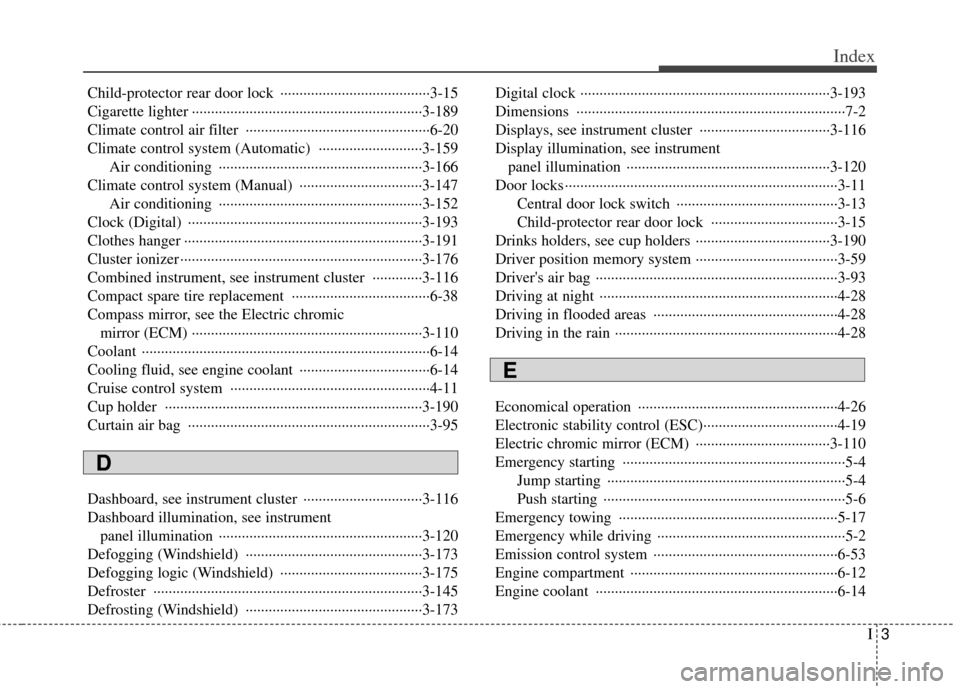
I3
Index
Child-protector rear door lock ··················\
··················\
···3-15
Cigarette lighter ··················\
··················\
··················\
······3-189
Climate control air filter ··················\
··················\
············6-20
Climate control system (Automatic) ··················\
·········3-159Air conditioning ··················\
··················\
·················3-16\
6
Climate control system (Manual) ··················\
··············3-147 Air conditioning ··················\
··················\
·················3-15\
2
Clock (Digital) ··················\
··················\
··················\
·······3-193
Clothes hanger ··················\
··················\
··················\
········3-191
Cluster ionizer ··················\
··················\
··················\
·········3-176
Combined instrument, see instrument cluster ·············3-116
Compact spare tire replacement ··················\
··················\
6-38
Compass mirror, see the Electric chromic mirror (ECM) ···············\
··················\
··················\
·········3-110
Coolant ················\
··················\
··················\
··················\
·····6-14
Cooling fluid, see engine coolant ··················\
················6-14
Cruise control system ··················\
··················\
················4-11
Cup holder ··················\
··················\
··················\
·············3-190
Curtain air bag ··················\
··················\
··················\
·········3-95
Dashboard, see instrument cluster ··················\
·············3-116
Dashboard illumination, see instrument panel illumination ··················\
··················\
·················3-12\
0
Defogging (Windshield) ··················\
··················\
··········3-173
Defogging logic (Windshield) ··················\
··················\
·3-175
Defroster ················\
··················\
··················\
··················\
3-145
Defrosting (Windshield) ··················\
··················\
··········3-173 Digital clock ··················\
··················\
··················\
···········3-193
Dimensions ················\
··················\
··················\
··················\
7-2
Displays, see instrument cluster ··················\
················3-116
Display illumination, see instrument
panel illumination ··················\
··················\
·················3-12\
0
Door locks ··················\
··················\
··················\
·················3-11\
Central door lock switch ··················\
··················\
······3-13
Child-protector rear door lock ··················\
···············3-15
Drinks holders, see cup holders ··················\
·················3-19\
0
Driver position memory system ··················\
··················\
·3-59
Driver's air bag ··················\
··················\
··················\
·········3-93
Driving at night ··················\
··················\
··················\
········4-28
Driving in flooded areas ··················\
··················\
············4-28
Driving in the rain ··················\
··················\
··················\
····4-28
Economical operation ··················\
··················\
················4-26
Electronic stability control (ESC)··················\
·················4-19\
Electric chromic mirror (ECM) ··················\
·················3-11\
0
Emergency starting ··················\
··················\
··················\
····5-4 Jump starting ··················\
··················\
··················\
········5-4
Push starting ··················\
··················\
··················\
·········5-6
Emergency towing ··················\
··················\
··················\
···5-17
Emergency while driving ··················\
··················\
·············5-2
Emission control system ··················\
··················\
············6-53
Engine compartment ··················\
··················\
··················\
6-12
Engine coolant ··················\
··················\
··················\
·········6-14
D
E